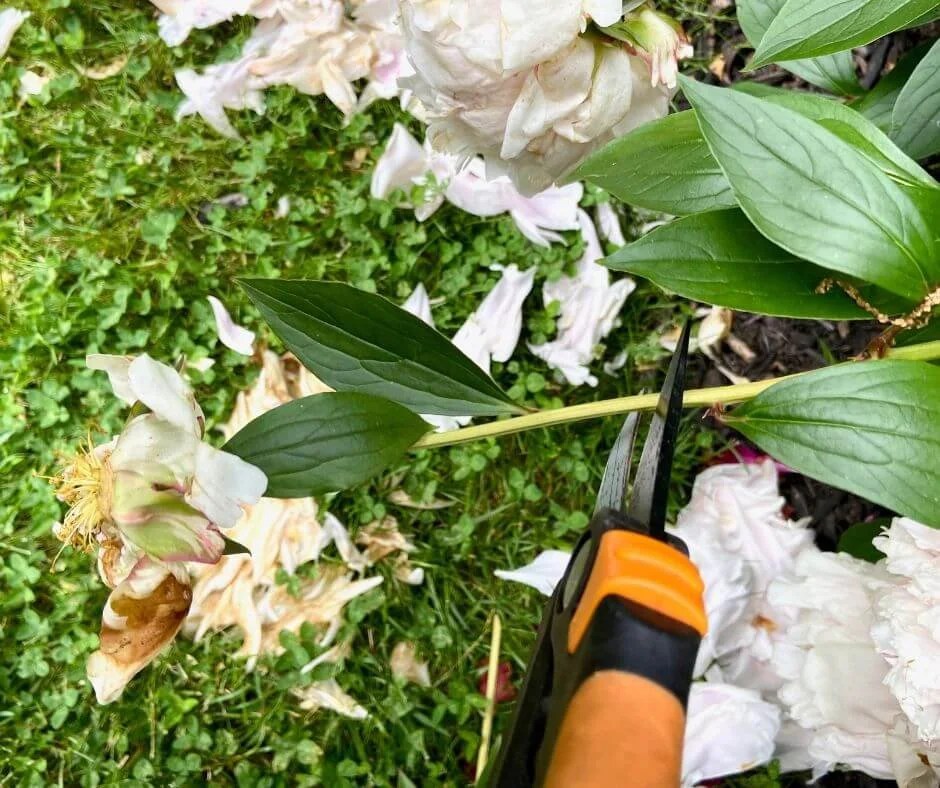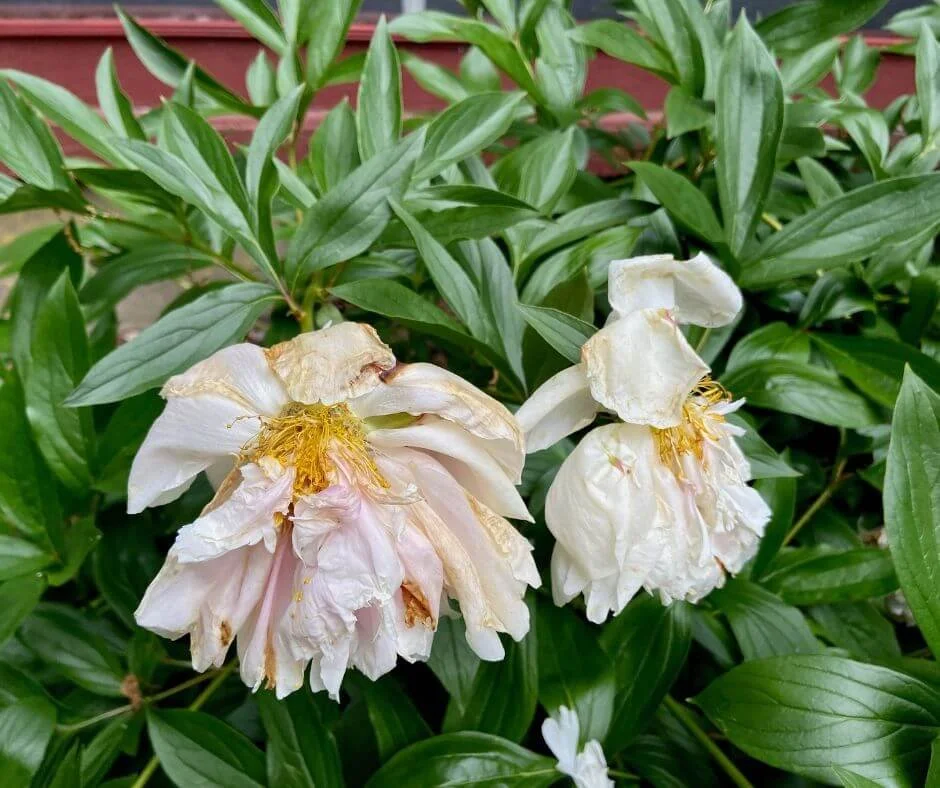The Art of Deadheading Peonies - Essential Tips
Deadheading Peonies
Post Updated 6/25/23
Deadheading peonies is an essential part of their care, but it can be a little confusing to know when and how to do it.
In this blog post, we will discuss the benefits of deadheading peonies, as well as how and when to do it for the best results.
Keep reading for essential tips on deadheading peonies!
The items listed are accompanied by affiliate links, meaning I earn a small commission if a purchase is made through my links. This has no impact on the cost to the consumer. I link to products this way whenever possible, and it has no bearing on the products I choose to review or recommend.
What is Deadheading?
Deadheading is an important gardening practice for all flower lovers. It is the process of removing spent blooms or faded flowers from a plant to allow growth and conserve resources, resulting in a fuller, healthier garden.
Done regularly, deadheading flowers can ensure that your garden looks beautiful for longer periods and helps to promote the health of all of your plants.
With just a few minutes of commitment each week, you can have vibrant blooms in your garden any season!
Perennial Peony Flowers
Beautiful peony blooms are on display in the garden.
Benefits of Deadheading Peonies
Deadheading peonies offers several benefits including:
Longer Blooming Time
With their full, voluminous petals in bloom, peonies offer a stunning reminder of the beauty that nature has to offer. For a longer and more beautiful blooming season, deadheading is the way to go!
By removing spent blooms, the plant can focus its energy on producing more flowers rather than expending it on producing seeds.
This means that not only does your garden stay neat for longer, but it also gets the benefit of an extra boost of energy!
So, if you want to witness longer bloom times in your garden, give deadheading a try. It's a simple but effective way to keep your growing peonies looking their best!
Who wouldn’t want these blooms to last longer? They are stunners!
An alluring visual appeal
Deadheading your peony plant can be a great way to create an aesthetically pleasing backyard or garden.
When it comes to peonies, deadheading actively enhances the visual appeal of the bush by keeping it neat and preventing overcrowding. This helps maintain control over your garden.
Peony blooms are quite large, so if you leave them on for too long, you could end up having an overcrowded bush that may look unappealing.
Deadheading these beautiful flowers is an easy and free way to keep your garden looking its very best!
Promotes Air Circulation
By removing dead blooms and foliage, you are also promoting better air circulation around the plant.
This helps to reduce the risk of disease and pests while it increases your peonies' ability to absorb sunlight and other nutrients necessary for growth.
Prevents Disease and Pests
Deadheading peonies is an important part of preventive garden care; it helps to protect against fungal diseases such as powdery mildew or botrytis, which can cause damage to the plant or spread quickly throughout the garden.
Moreover, by removing any dead foliage or petals, there is less chance of attracting insects and other pests that feed on decomposing matter.
With a little dedicated deadheading, your peony plants will remain healthy and pest-free throughout the season.
Reduces Strain on Stems
Peonies are renowned for their grand and gorgeous blooms, however, they tend to be top-heavy due to the weight of their blooms.
This often puts extra pressure on the stems of these exquisite flowers. If not properly supported, stalks and stems may easily become unstable under the pressure of their lush blossoms - particularly during times of precipitation.
By regularly deadheading peonies, you are removing some of that strain and helping your plants to stay upright and healthy. Flopping peonies is a thing of the past!
When is the Best Time to Deadhead Peonies?
The best time to deadhead peonies is just after the flowers have begun to fade and die.
These are peony blooms that are good candidates to deadhead.
Peonies generally reach their peak beauty within 7-10 days of blooming, after which point these perennials will start to wilt.
Deadheading should be done regularly throughout the blooming period (April - June).
It is crucial to remember that each peony type will not blossom simultaneously - their flowering season depends on its variety.
For example, numerous varieties of herbaceous peonies are categorized into early, mid-season, and late bloomers.
These are the stages of a flowering of a peony.
Signs Your Peonies Should Be Deadheaded
Here are some sure signs that it is time to deadhead flowers:
Look out for brown petals, wilted leaves, petals that have already fallen off, and droopy flowers - this is an indication that it is time to start snipping away!
When done at the right time, pruning peonies will not harm the plant in any way - so start deadheading today!
These peony petals are spent and will need to be deadheaded.
How to Deadhead Peonies
Ok your peonies are starting to decline and you know you want to deadhead them to help maintain the health of the plant but how do you do it?
It’s quite simple! All you need is a pair of sharp pruning shears and the ability to identify dead or dying flowers.
Make sure your shears are clean before cutting backing peonies to reduce the risk of spreading disease.
Once you have identified the dead peony flower, simply snip off the flower heads and stems with your shears just above the first set of leaves.
If any leaves have died back, they should too be removed for the sake of good air circulation and to reduce the chances of disease.
Once you’re done, clear away any debris left behind as this can also attract pests and diseases.
Check out Nature Hills if you are looking to purchase some beautiful peonies.
FAQS About Deadheading Peonies
Should you deadhead peonies?
Yes, you should deadhead your peonies. All flowering plants can benefit from deadheading, and peonies are no exception.
Regular deadheading will encourage the plant to send out flowering instead of seed production.
Will peonies rebloom after deadheading?
Deadheading peonies isn't about forcing them to rebloom, but instead redirecting the plant's energy toward their existing flowers. Not only does this help extend your bloom season, but it also aids in disease prevention and keeps your plants vibrant year-round!
Should you trim down your peonies before winter?
Pruning your peonies at the end of fall before winter can be tremendously beneficial. Not only will it help the plant store its energy in preparation for spring, but it will also result in healthier and more abundant new flowers when the growing season arrives!
RELATED: Peony Fertilizer 101: The Ultimate Guide to Fertilizing Peonies
Deadheading Peonies Flowers
For vibrant, long-lasting peonies in your garden, deadheading is a critical part of their proper care.
Not only does it help to keep your plants healthy and vibrant, but it can also extend the bloom season significantly.
By regularly snipping away a dead flower or a faded bloom with a pair of sharp pruning shears, you can keep your peony bushes looking their absolute best!
So don’t wait any longer - get out there and start deadheading those lovely peony flowers today!




















